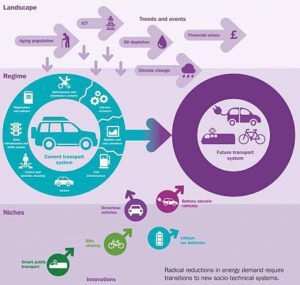Start date: 1 February, 2015
- End date: 1 May, 2018
Although reducing energy consumption in transport is notoriously difficult, efforts to do so by governments, corporate actors, civic society and citizens have increased markedly over the past decade. City-regions have become particularly important loci for innovations aimed at reducing greenhouse gas emissions and energy consumption, and many cities (e.g. London, Oxford, Paris, Freiburg) have come to fulfil a test-bed function where experimentation with low energy innovations is concentrated. A wide array of innovations can be identified, focusing on both the ‘hardware’ of physical infrastructure and vehicles (e.g. bicycle lanes, wireless electric vehicle recharging, light rail systems) and the ‘software’ of institutions and practices (e.g. car and bicycle sharing schemes, congestion charging). Nonetheless, successes with regard to the emergence of low energy innovations in urban transport are geographically uneven: there are clear differences between city-regions and among different parts of individual city-regions. This suggests that transferability of innovations in urban transport cannot be assumed, and raises questions about how the flourishing of low energy innovations in urban transport in particular places can be maximised.

The project will identify which factors and processes facilitate and obstruct low energy innovation in urban transport, examine to which extent these factors and processes are transferable across and within city-regions, and provide suggestions about what (local) governments and other stakeholders can do to stimulate the success of such innovations.
Project Documents
Project Outline (1 MB - pdf)
Summary of key findings (248 KB - pdf)
Four paper sessions at 4S/EASST conference 2016
Tim Schwanen organised four paper sessions on ‘Infrastructure in Practice and in Flux’ during the 4s/EASST conference in Barcelona on 31 August – 3 September. The sessions were organised as part of the ‘Conceptualising Infrastructures, Innovation and Demand’ project in which CIED and DEMAND collaborate. Tim Schwanen also presented a paper at 4S/EASST titled ‘Infrastructure’s allure’.
Presentation during the Annual International Conference of the Royal Geographical Society
From 1-4 September 2015, Dr Tim Schwanen gave a presentation entitled ‘Inovationscapes in urban mobility: can cities lead the way in sustainability transitions in passenger transport’ during the
Annual International Conference of the Royal Geographical Society, in Exeter.
Presentation during the Fourth Global Conference on Economic Geography
In August 2015, Dr Tim Schwanen gave a presentation on entitled ‘Sustainability transitions and geography: the role of cities in low energy urban mobility’ during the Fourth Global Conference on Economic Geography, in Oxford.
Keynote presentation entitled ‘Cycling and walking the city: an assessment of transport research on active travel’ ' event
On 20th and 22nd July 2015, Dr Tim Schwanen gave a keynote presentation entitled ‘Cycling and walking the city: an assessment of transport research on active travel’ in a workshop on ‘Active travel and physical activity – bridge the gap’ at the
IATBR 2015 conference in Windsor.
Keynote speaker at 'Sustainable Transport: Drivers for Change' event
On 20th May 2015, Dr Tim Schwanen was the keynote speaker at the ‘Sustainable Transport: Drivers for Change’ event in Oxford, organised by
Low Carbon Oxford. The event was targeted at reps from businesses and other organisations in/around Oxford, and saw about 30 people attending. The presentation slides are available for download
here.
Event with Cyclox
On 14th May 2015, Dr Tim Schwanen organised a seminar/workshop with
Cyclox, a cycling campaigning group in Oxford, to discuss findings from his research that was conducted on a high profile retrofit project in Oxford. The event was attended by appprox 40 people and received very positive feedback from both attendees and organisers of Cyclox, who considered the debate highly encouraging for everyone hoping to see Oxford become a beacon for bike use.
Participation in the ‘Oxford OLEV Fund Steering Group Meeting’
Dr Tim Schwanen attended two meetings in the context of the ‘Oxford OLEV Fund Steering Group Meeting’ – this comprises staff members from Oxford City Council, Oxfordshire County Council, Energy Savings Trust and University of Oxford (TS) and will oversee and develop bids for three Office for Low Emission Vehicles (OLEV) programmes – a bus scheme, a taxi scheme for which Oxford has been admitted to the second round. For more information on the scheme, please refer to the Department of Transport’s press release
here. Further meetings and proposal writing over the next few months are planned as deadlines for the three schemes are likely to be in August and September
Panellist and paper presentation at the Annual Meeting of the Association of American Geographers
On 21-25 April 2015, Dr Tim Schwanen travelled to Chicago to attend the ‘ Socio-Technical (Sustainability) Transitions in the making: emerging geographies of eco-innovation and green industrial change 2’ meeting where he will present his paper on:
Geographies of eco-innovations in urban mobility: how state restructuring complicates sustainability transitions in passenger transport. During this 5 day event at the Annual Meeting of the Association of American Geographers, Dr Schwanen was also a panellist in a session on ‘
Unlocking Low Carbon Mobility’, and in the session on ‘
CITY Debates: Can resilience as a concept be saved?’.
Seminar at the DEMAND Centre
On 18
th March, Dr Tim Schwanen gave a seminar on ‘Reducing energy consumption in urban transport’ at the DEMAND centre.
Read more about the seminar.
Speaker at the Hilary term 2015 Transport Studies Unit Seminar Seriese
On 17th March 2015, Dr Tim Schwanen was invited as one of the speakers in a seminar in the Hilar term 2015 Transport Studies Unit seminar series ‘The Scalar Politics of Transport’. Tim’s talk was called ‘A new regional élan? Transport investment in the re-scaling competition state’ and formed part of the seminar on 17
th March which had as its title ‘
Politics of Infrastructure: Spineless Development?’
Presentation on 'Understanding low energy innovation in urban mobility' given at AAG, Florida
On 16th April 2014 Dr Tim Schwanen gave a presentation at the Annual Meeting of the Association of American Geographers (AAG) in Tampa Florida. Download the presentation
Understanding low energy innovation in urban mobility AAG presentation [PDF 133.68KB]Keynote presentation on 'Revisting socio-technical ecologies of innovation, Linköping
Dr Tim Schwanen gave a keynote presentation during the International Time Geography Days conference May 14-16 2014 which took place in Linköping, Sweden. Download the presentation slides
Revisiting socio-technical ecologies of innovation [PDF 328.53KB]Lecture 'Beyond Automobility' given at University of Gothenburg
On 12th May 2014, Dr Tim Schwanen gave a lecture at the University of Gothenburg ‘Beyond Automobility’.
With the publication of the Fifth Assessment Report of the IPCC it is more evident than ever that greenhouse gas (GHG) emissions need to be curbed drastically and as soon as possible. Transport is widely regarded as one of the difficult sectors in which to reduce energy consumption and GHG emissions. Attempts to do so typically rely on technological fixes, economic measures and ‘soft’ behaviour change programmes; engineering, economics and psychology are the academic disciplines that have the greatest impact on public policies and other interventions aiming to reduce emissions from transport. In recent years, however, sociologists, geographers and cultural theorists have begun to elaborate a range of complementary and alternative perspectives on energy consumption and GHG emissions in transport and other domains of society. Focusing on the land-based mobility of people (i.e. excluding freight, maritime and air transport),Tim’s lecture outlined one such perspective. This built on , and also engaged critically with, the previous and ongoing work of a range of mainly UK-based social scientists. It located the difficulty of reducing GH emissions in the nature of automobility, which is – in line with recent thinking on object-oriented ontologies and the speculative realism movement in continental philosophy – conceptualised not as a system or regime but as an object.
Tim went on to discuss how and under what conditions this object can be changed. Urban passenger transport was discussed, with a particular focus on UK cities. The lecture concluded that ongoing developments in those cities are in alignment with expectations that can be derived from an object-oriented conceptualisation of automobility. This raises the question whether the numerous innovations in and experiments with sustainable transport will be sufficient to reduce GHG emissions and energy consumption on the scale that is required to drastically limit transport’s contribution to anthropogenic climate change.
Workshop with Brighton and Hove City Council
On Thursday 28
th May CIED convened a research workshop with key members of Brighton and Hove City Council as part of CIED’s endeavours to ensure that its energy demand research relevant, accessible and policy focused. With a first round of research projects already underway CIED is starting to develop ideas for a second round of projects. The aim of this workshop was to discuss opportunities to match projects where possible to city priorities where there could be a mutual benefit and knowledge sharing potential. Opportunities explored were possible placement of researchers within the council for short secondments to facilitate knowledge exchange and sharing of research findings to support council policy development.
Tim Schwanen, Co-Director presented an outline of the project Innovations in urban transport ‘and shared some initial findings. A subsequent round table discussion on the project identified several opportunities for future collaboration on transport related issues.
Download the Presentation to Brighton and Hove Council [PDF 74.59KB]
Workshop on 'activity-travel behaviour analysis', Hong Kong
On 13th December 2013, Dr Tim Schwanen delivered a workshop at Hong Kong Baptist University on ‘activity-travel behaviour analysis. Download the presentation
Understanding low energy innovation in passenger transport [PDF 223.54KB]

